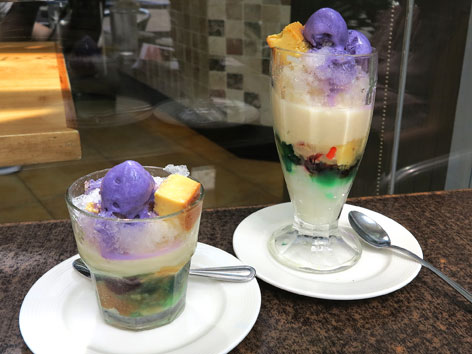Ethiopian Chicken Stew (Doro Wett)
Ethiopia
amantour
guides you to the best local dishes & drinks in
125+ cities. See map now



.jpg) Going somewhere and wish you could take all of a city’s Eat Your World info with you? With EYW’s Kindle and City Guides, you can! Don’t miss out on any local foods or drinks during your next trip.
Going somewhere and wish you could take all of a city’s Eat Your World info with you? With EYW’s Kindle and City Guides, you can! Don’t miss out on any local foods or drinks during your next trip.
EYW wants your food photos!

EYW wants your food stories!
Hey guys I am a traveler who loves to explore different places around the world. I often visit outside of Canada, So whenever I have to travel around the world I always book my flight tickets from the... Read more

What: Halu-halo (“ha-loo-ha-loh,” also halo-halo), literally “mix-mix,” means all mixed up, and indeed it is, in its unique, yummy Filipino way. This king of desserts is a crazy combination of ingredients separately boiled in sugar, including: stewed saba (“sah-bah,” plantains), cooked langka (“lang-kah,” ripe jackfruit), garbanzo beans, red beans, white kidney beans, gulaman (“goo-lah-man,” a jelly made from seaweed, see sago’t gulaman), kaong (“kah-ong,” sugar palm fruit), nata de coco (“nah-tah de coh-coh,” jelly-like cubes from fermented coconut water), macapuno (“mah-kah-poo-no,” a natural mutation of coconuts that produce gelatinous coconut flesh and no coconut water). And that’s just the bottom part of the serving glass or bowl! That whole shebang is covered with shaved ice, drizzled with evaporated milk, sprinkled with sugar, topped with a small scoop of ube halaya (“ooh-beh ha-la-ya,” purple yam that’s boiled and mashed with sugar and condensed milk), leche flan, and pinipig (“pee-nee-pig,” grains of young rice that are pounded into flakes and toasted). Sadly, proper pinipig is hard to find these days; many vendors will skip it altogether or substitute corn flakes or rice krispies, which just don’t make the grade.
Compared to traditional Filipino fare, mostly Chinese and Spanish heritage dishes, halu-halo appears to be a fairly recent invention—a product of the Japanese occupation of Manila during World War II. Monggo-ya (from Philippine monggo, or mung beans, and ya, Japanese kanji for “store” or “room”) were a type of makeshift shop that sold a localized version of kakigori, a Japanese dessert that combined shaved ice and sweetened red mung beans. So how did halu-halo come to evolve with its epic list of ingredients? We have yet to find out!
Good to know: It’s said that halu-halo’s closest cousin is ice kacang, a dessert found in Singapore, Malaysia, and Brunei that uses sweetened red beans, grass jelly, sweet corn, and fresh seasonal fruit, and is likewise topped with shaved ice and milk. But ice kacang is no match for halu-halo in terms of the number of components mixed in. And while most shaved-ice desserts in Asia place the sweet tidbits over the ice, halu-halo puts all the sweetness at the bottom, buries them in ice, and adds more stuff on top. Furthermore, halu-halo uses only cooked tidbits; the inclusion of uncooked fruits is unheard of.
Where: Conti’s (632-856-2352, multiple locations including Serendra, Fort Bonifacio High St., Taguig, map), a family-friendly place known for its savory meals and delectable desserts, serves one of our favorite halu-halos. Its bewildering list of cakes and other baked goods to take home is not for the faint-hearted.
When: Sun-Thurs, 8am-10pm; Fri & Sat, 8am-11pm
Order: We ordered a Halu-halo Special (Php 110) and the smaller Halu-halo Jr. (Php 65), just because, and got more than we expected. This is a truly rich halu-halo. The ingredient list (for both) is slightly more modest than what’s listed above, with red beans, saba, gulaman, kaong, macapuno, leche flan, ube ice cream (instead of ube halaya), and milk. However, the ice cream turned the mix a lovely creamy purple; the macapuno was sweet, lightly coconutty, and mouth-meltingly perfect; and the generous cubes of leche flan proved to be a blockbuster. The shaved ice and ice cream quickly melted in the tropical heat, but we didn’t mind. We were in dessert heaven.
Alternatively: In a rush and searching for a fast-food fix? Duck into a Chowking branch (multiple locations including Glorietta 5, Ayala Ave., Makati City, map) for its halu-halo. It comes in petite and “fiesta” sizes, with a scoop of ice cream for a small additional fee. It is not as heavenly as Conti’s, but it is definitely a respectable version, and a very popular item in soaring summer temperatures. For more genteel surroundings, head to The Lobby of The Peninsula Manila (632-887-2888, ext. 6759; corner Makati & Ayala Aves., Makati City, map) for its Halu-Halo Harana (“hah-rah-nah,” serenade). It’s pricey, at 400 Php, but you’ll relish the tender, sweet bits of banana, jackfruit,beans, gulaman, kaong, ube ice cream, and leche flan, all sprinkled with real pinipig on top. The Lobby offers an elegant escape from Manila’s harried pace, and if you’re lucky, you might enjoy your halu-halo while being serenaded by some local singers.
©2025 Eat Your World, LLC - All Rights Reserved